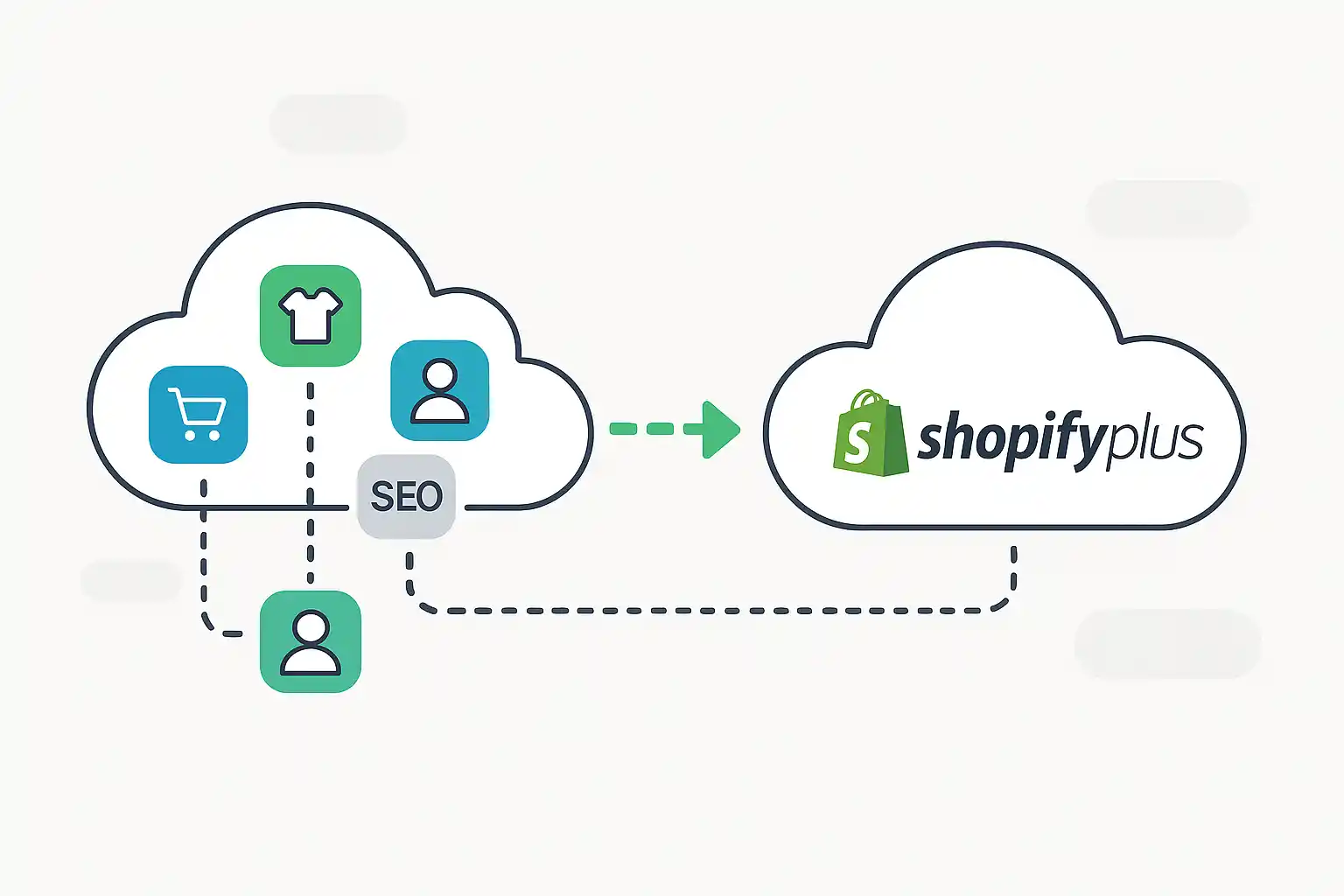November 5, 20248 min read
Migrating to Shopify Plus is a big step for any growing eCommerce business. Whether you’re moving from WooCommerce, Magento, BigCommerce, or any other platform, this upgrade brings more scalability, flexibility, and automation. But without proper planning, a migration can lead to downtime, data loss, or SEO issues, which can hurt your sales.


By Safwan
November 5, 20248 min read
Get in touch with our team to discuss your Shopify development needs.
Lets TalkShopify Plus is designed for high-growth brands that need advanced features, faster performance, and better customer experience. But moving your entire store—products, customers, orders, and content—requires careful execution.
This article discusses multiple facets of migrating to Shopify Plus. From pre-migration planning to data transfer, SEO setup, and post-launch checks, this post ensures a seamless transition with minimal disruptions.
Let’s dive in and make your Shopify Plus migration smooth and successful.
Scaling a growing eCommerce brand requires a platform that handles high traffic, automates tasks, and provides flexibility—this is where Shopify Plus comes. Unlike standard Shopify, Shopify Plus offers advanced customization, powerful automation, and enterprise-level support, making it the perfect choice for high-volume brands.
Key reasons to migrate:
Scalability– Shopify Plus handles thousands of transactions per minute without downtime, ensuring a seamless shopping experience during peak sales events.
Advanced Customization– With Shopify Scripts and Checkout Extensibility, brands can personalize the checkout process, apply dynamic discounts, and optimize conversion rates.
Automation & Efficiency – Shopify Flow automates inventory management, customer segmentation, and order processing, saving time and reducing manual work.
Better Performance & Speed– Built-in CDN and high-speed servers improve page load times, crucial for reducing bounce rates and boosting conversions.
Multi-Channel & International Selling – Sell globally with multiple currencies, languages, and localized storefronts, making cross-border expansion effortless.
Dedicated Support & Exclusive Apps– Get 24/7 priority support, access to Shopify Plus Academy, and exclusive apps that simplify business operations.
Before transitioning to Shopify Plus, consider the following factors:
Cost– Shopify Plus starts at $2,000/month. Ensure it aligns with your budget.
Feature Utilization– Identify which Plus features your business truly needs.
Customization Needs– If you require extensive backend modifications, Shopify Plus offers robust customization tools.
SEO & Data Transfer– Plan how product data, customer details, and SEO rankings will be maintained.
Development Resources– Decide whether you need a Shopify Plus partner or in-house developers.
A well-structured migration plan ensures a smooth transition. Here’s what to do before migrating:
First things first—migration is not just about moving data. It’s about making sure everything stays intact, from SEO to customer experience. Here’s what you need to do:
Set Clear Goals – What do you want to improve with Shopify Plus? More automation? Better checkout experiences? Know your priorities
Audit Your Current Store –List out all your products, pages, customer data, integrations, and SEO rankings.
Choose a Migration Method –Will you do it manually, use a migration tool, or hire a Shopify Plus expert?
Create a Timeline –Pick a low-traffic period to move things over to minimize disruptions.
Data migration is the heart of the process. Here’s what needs to be moved:
Product Catalog– Titles, descriptions, prices, images, and SKUs
Customer Data– Email addresses, order history, and account details
Order History– Keep past orders intact so customers don’t lose their records
Blog & Content Pages – Don’t forget your SEO-optimized content
How You can migrate data?
Now that your data is in place, it’s time to set up your store:
Pick a Theme– You can go for a pre-built Shopify theme or a custom one.
Customize Your Store– Modify layouts, colors, and branding to match your identity.
Configure Checkout & Payment Settings– One of the best features of Shopify Plus is advanced checkout customization. Use Shopify Scripts to create personalized offers.
Set Up Email & Notifications– Keep your customers informed with branded order emails.
If you were using third-party tools on your old platform, it is the time to bring them over.
Check App Compatibility – Some apps might not work on Shopify Plus, so find alternatives if needed.
Reinstall Marketing & Analytics Tools– Google Analytics, Meta Pixel, and email marketing integrations.
Connect Inventory & Fulfillment Services– Ensure smooth order processing with automation.
SEO is crucial—you don’t want to lose rankings when switching platforms.
Keep URL Structure Consistent – If Shopify changes your URLs, use 301 redirects.
Update Sitemap & Submit to Google – Let search engines know about the new store setup.
Monitor Search Performance– Track rankings to spot any dips and fix them fast.
Before going live, do final check:
Test Checkout Process– Run test transactions to ensure payments work smoothly.
Check Mobile Responsiveness– Ensure a seamless mobile shopping experience.
Fix Any Bugs– Click through all pages to spot broken links or missing images.
Perform Speed Tests– A slow site hurts conversions, so optimize loading times.
It’s time to go live:
Announce Your Launch– Email your customers and promote on social media.
Monitor Site Performance– Use Shopify Analytics and Google Analytics to track real-time traffic.
Fix any post-launch issues– Be ready to tweak and improve based on customer feedback.
Leverage shopify plus features– Use Shopify flow for automation, Launchpad for timed sales, and Shopify Scripts for customized discounts.
Once your Shopify Plus store is live, it’s time to optimize your store to maximize its potential:
Speed Optimization: Compress images, enable lazy loading, and use Shopify’s built-in CDN.
Enhance User Experience– Improve navigation, add search filters, and refine your checkout flow.
Leverage Advanced Analytics– Use Shopify Plus analytics, Google Analytics, and heatmaps to track customer behavior.
Implement Email Marketing– Send automated abandoned cart emails and personalized offers.
A/B Test Your Pages– Run A/B tests on product pages and checkout flows to increase conversions.
Monitor and Improve SEO– Keep updating meta tags, internal linking, and content strategy.
Optimize for Mobile Users – Ensure fast load times and seamless mobile UX.
Post-migration optimization is essential to ensure a smooth transition and maximize the benefits of moving to Shopify Plus.
After migration, your store may face issues like SEO disruptions, slower site speed, or unexpected technical glitches. Optimizing your store helps maintain search engine rankings by setting up proper redirects, updating meta tags, and ensuring fast load times.
Enhancing the user experience—through better navigation, mobile responsiveness, and checkout improvements—keeps customers engaged and reduces bounce rates.
Additionally, Shopify Plus offers powerful features like automation, advanced analytics, and customized checkout experiences that should be fully leveraged post-migration. By continuously monitoring performance, optimizing conversions, and resolving any lingering bugs, you can ensure your Shopify Plus store operates at peak efficiency, ultimately leading to higher customer retention and increased revenue.
Migrating to Shopify Plus is a game-changer for scaling your eCommerce business. A well-planned migration ensures seamless data transfer, optimized SEO, and enhanced functionality, setting the foundation for long-term success. However, the journey doesn’t stop at migration—continuous optimization is key to maximizing growth.
Our Shopify experts can make the transition effortless. Let’s get your store running on Shopify Plus smoothly. Click here to discuss your project with us.
1. How long does it take to migrate to Shopify Plus?
The timeline depends on your store size and complexity, but most migrations take 4-8 weeks with proper planning.
2. Will I lose my SEO rankings after migration?
No, if you set up proper 301 redirects, maintain URL structures, and optimize metadata, your rankings should remain stable.
3. Can I migrate customer accounts and order history?
Yes, Shopify Plus supports full customer and order data migration, but passwords cannot be transferred directly. Customers may need to reset them.
4. What happens to my third-party integrations?
You will need to reconnect or replace some apps, but Shopify Plus has robust API support to integrate most tools.
April 4, 202510 min read
Introduction Personalization has become a game-changer in eCommerce, allowing brands to offer tailored experiences that resonate with their customers. Shopify Plus provides advanced tools to ...Read More
March 26, 20258 min read
The checkout page is the most crucial part of your Shopify store—it’s where conversions happen. For Shopify merchants seeking to maximize conversions and provide a ...Read More
March 20, 20256 min read
In today’s fast-paced eCommerce landscape, Shopify CRM integration is essential for delivering a seamless and personalized customer experience. By integrating a CRM system with Shopify, ...Read More